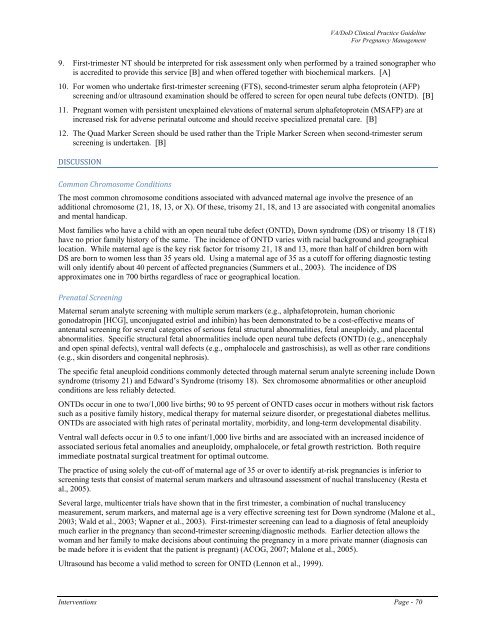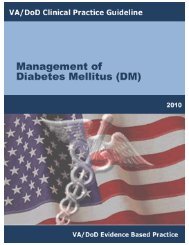Management of pregnancy - VA/DoD Clinical Practice Guidelines ...
Management of pregnancy - VA/DoD Clinical Practice Guidelines ...
Management of pregnancy - VA/DoD Clinical Practice Guidelines ...
You also want an ePaper? Increase the reach of your titles
YUMPU automatically turns print PDFs into web optimized ePapers that Google loves.
<strong>VA</strong>/<strong>DoD</strong> <strong>Clinical</strong> <strong>Practice</strong> Guideline<br />
For Pregnancy <strong>Management</strong><br />
9. First-trimester NT should be interpreted for risk assessment only when performed by a trained sonographer who<br />
is accredited to provide this service [B] and when <strong>of</strong>fered together with biochemical markers. [A]<br />
10. For women who undertake first-trimester screening (FTS), second-trimester serum alpha fetoprotein (AFP)<br />
screening and/or ultrasound examination should be <strong>of</strong>fered to screen for open neural tube defects (ONTD). [B]<br />
11.<br />
12.<br />
Pregnant women with persistent unexplained elevations <strong>of</strong> maternal serum alphafetoprotein (MSAFP) are at<br />
increased risk for adverse perinatal outcome and should receive specialized prenatal care. [B]<br />
The Quad Marker Screen should be used rather than the Triple Marker Screen when second-trimester serum<br />
screening is undertaken. [B]<br />
DISCUSSION<br />
Common Chromosome Conditions<br />
The most common chromosome conditions associated with advanced maternal age involve the presence <strong>of</strong> an<br />
additional chromosome (21, 18, 13, or X). Of these, trisomy 21, 18, and 13 are associated with congenital anomalies<br />
and mental handicap.<br />
Most families who have a child with an open neural tube defect (ONTD), Down syndrome (DS) or trisomy 18 (T18)<br />
have no prior family history <strong>of</strong> the same. The incidence <strong>of</strong> ONTD varies with racial background and geographical<br />
location. While maternal age is the key risk factor for trisomy 21, 18 and 13, more than half <strong>of</strong> children born with<br />
DS are born to women less than 35 years old. Using a maternal age <strong>of</strong> 35 as a cut<strong>of</strong>f for <strong>of</strong>fering diagnostic testing<br />
will only identify about 40 percent <strong>of</strong> affected pregnancies (Summers et al., 2003). The incidence <strong>of</strong> DS<br />
approximates one in 700 births regardless <strong>of</strong> race or geographical location.<br />
Prenatal Screening<br />
Maternal serum analyte screening with multiple serum markers (e.g., alphafetoprotein, human chorionic<br />
gonodatropin [HCG], unconjugated estriol and inhibin) has been demonstrated to be a cost-effective means <strong>of</strong><br />
antenatal screening for several categories <strong>of</strong> serious fetal structural abnormalities, fetal aneuploidy, and placental<br />
abnormalities. Specific structural fetal abnormalities include open neural tube defects (ONTD) (e.g., anencephaly<br />
and open spinal defects), ventral wall defects (e.g., omphalocele and gastroschisis), as well as other rare conditions<br />
(e.g., skin disorders and congenital nephrosis).<br />
The specific fetal aneuploid conditions commonly detected through maternal serum analyte screening include Down<br />
syndrome (trisomy 21) and Edward’s Syndrome (trisomy 18). Sex chromosome abnormalities or other aneuploid<br />
conditions are less reliably detected.<br />
ONTDs occur in one to two/1,000 live births; 90 to 95 percent <strong>of</strong> ONTD cases occur in mothers without risk factors<br />
such as a positive family history, medical therapy for maternal seizure disorder, or pregestational diabetes mellitus.<br />
ONTDs are associated with high rates <strong>of</strong> perinatal mortality, morbidity, and long-term developmental disability.<br />
Ventral wall defects occur in 0.5 to one infant/1,000 live births and are associated with an increased incidence <strong>of</strong><br />
associated serious fetal anomalies and aneuploidy, omphalocele, or fetal growth restriction. Both require<br />
immediate postnatal surgical treatment for optimal outcome.<br />
The practice <strong>of</strong> using solely the cut-<strong>of</strong>f <strong>of</strong> maternal age <strong>of</strong> 35 or over to identify at-risk pregnancies is inferior to<br />
screening tests that consist <strong>of</strong> maternal serum markers and ultrasound assessment <strong>of</strong> nuchal translucency (Resta et<br />
al., 2005).<br />
Several large, multicenter trials have shown that in the first trimester, a combination <strong>of</strong> nuchal translucency<br />
measurement, serum markers, and maternal age is a very effective screening test for Down syndrome (Malone et al.,<br />
2003; Wald et al., 2003; Wapner et al., 2003). First-trimester screening can lead to a diagnosis <strong>of</strong> fetal aneuploidy<br />
much earlier in the <strong>pregnancy</strong> than second-trimester screening/diagnostic methods. Earlier detection allows the<br />
woman and her family to make decisions about continuing the <strong>pregnancy</strong> in a more private manner (diagnosis can<br />
be made before it is evident that the patient is pregnant) (ACOG, 2007; Malone et al., 2005).<br />
Ultrasound has become a valid method to screen for ONTD (Lennon et al., 1999).<br />
Interventions Page - 70
















